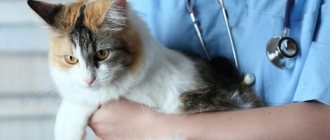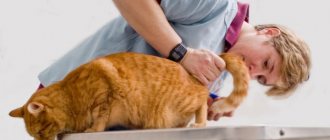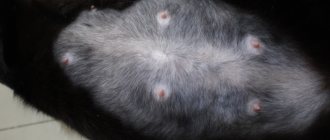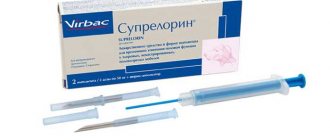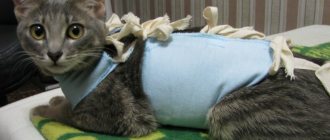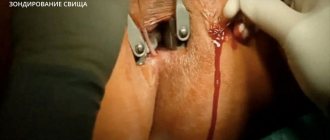After 7-9 months from birth, the cat becomes sexually mature. This means unusual behavior of the pet, loud screams, scratching, noisy fussing at night. Not every owner is happy to see the persistent desire to see a cat, as well as the appearance of offspring. To avoid health problems from unfulfilled cat instincts and difficulties with the placement of numerous kittens, a special operation has been developed - cat sterilization.
Today there are several approaches to this important and sensitive issue of cat health and peace of mind, so let’s dive into the nuances of surgical intervention in the cat’s body in order to prevent the possibility of the animal’s reproduction.
Pros and cons of sterilization
Sterilization, like any surgical process, has advantages and disadvantages.
The arguments “For” include the following arguments:
- a cat is capable of bringing kittens not only annually, but even quarterly, up to 6 kittens at a time. Not all owners want to solve the problem of finding homes for all their children;
- the behavior of an animal during estrus is often inadequate: nighttime guttural cries, lack of appetite, a pervasive smell of urine in the house due to the cat’s desire to mark everything around with its smell;
- if there are babies in the house, a sterilized animal will not bring infection into the house;
- bearing and giving birth to offspring can cost the life of the owner’s beloved cat;
- if a cat is not allowed near the cat during heat, then a large amount of extra hormones appears, which has a detrimental effect on the pet’s psyche;
- increasing the lifespan of a cat.
It is also worth listening to the arguments “against” and drawing conclusions: this is an invasion of the natural course of events planned by nature. It turns out that a person first of all worries about his own peace of mind, and only then about the health of his pet.
The operation may not go as smoothly as we would like; it is difficult for the animal to recover from anesthesia and regain strength.
It is also important to understand that sterilization of a cat is an irreversible process, and the owner will never see kittens from his pet.
When to spay a cat
global $ads_google;
//data-ad-slot=”2475549904″ $ads_google = empty($ads_google) ? false : true; ?> if ($ads_google == false) {?> $ads_google = true; ?> } ?> At a young age, the operation is easier and more successful: the recommended age of the animal is 8-12 months. The cat is taken to the veterinarian for examination, because it is important to make sure that the pet is physically healthy and developed. Early surgery may cause developmental delays in the animal.
It is also possible to perform sterilization during estrus. But during this period, due to the large amount of hormones in the cat’s body, it will be difficult to recover from anesthesia, and the sutures may take longer to heal than usual. The best time to perform the operation is a couple of weeks before the hunting period or two weeks after it.
If estrus lasts a long time, interrupting only for 2-4 days, then it becomes difficult to find the time. In this case, the pet is sterilized to prevent excessive depletion of its body.
Another important question that concerns some owners: is it possible to sterilize a pregnant cat ? There is a separate name for this process: extirpation of the pregnant uterus. Surgery is performed in emergency cases that require saving the cat's life.
Types of cat sterilization
There are several ways to perform the operation: chemical and surgical.
- Tubal occlusion: The cat's fallopian tubes are ligated, eliminating the possibility of pregnancy. Although the intervention is surgical, the reproductive organs are not removed.
- Sterilization is classic - along the white line of the abdomen or an alternative option: through a side incision. In this case, the incision is made on the side, and the muscles are separated using a blunt method. Although the method is less traumatic than the previous one, the uterus is not always completely removed. No seam maintenance is required. An intradermal suture allows the cat to immediately resume its usual lifestyle, gradually restoring its health.
- Sterilization through a very small incision using a surgical hook. A synonym is laparoscopic sterilization, which is not entirely correct, since the peritoneum and skin are also cut, but with a much smaller incision along the length. A disinfected hook is inserted into the wound and used to hook the ligament to the ovary. A ligature is applied and the ovary with a ligament or the entire uterus is removed.
- Laparoscopy as sterilization (ecdoscopic): Thanks to endoscopic technologies, punctures are made in the skin of the abdominal wall and the uterus and ovaries are completely removed. Expensive equipment is used, so the cost of the operation remains high.
- Chemical method or temporary sterilization: a special implant containing a drug is inserted under the animal’s skin. The substance gradually enters the bloodstream and the cat develops a reversible sterilization effect for up to three years.
They choose the appropriate method responsibly: they study veterinary clinics and reviews of them from professional breeders. Saving money and haste are bad advisors in this matter.
Castration of a cat
If during sterilization , which is also called oophorectomy (OE), the ovaries are surgically removed, then during castration both the ovaries and the uterus are removed. Such intervention in the body can be planned or according to indications. There are no contraindications for castration based on the age of the cat.
How is laparoscopic sterilization performed?
After putting the animal under anesthesia, an incision of about 1 cm is made in order to insert a hook into the abdominal cavity. This device moves the intestinal loops and picks up the uterine horn. The uterus along with the ovaries are pulled out through a tiny wound.
This is possible due to the elasticity of cat tissues, especially at a young age.
Then the pulled out organs are strongly pulled out to apply a ligature to the arteries of the ovaries and ligaments, as well as to the horns of the uterus. The process of stretching is very serious, because in fact it is on the verge of breaking the ovarian ligament.
The uterus is cut off and removed, the centimeter incision is sutured: such a seam is not processed or covered with a blanket, since the cat will not be able to lick it.
Inpatient care
Preparing a cat for sterilization and proper care for it in the postoperative period are the main conditions that must be observed with special care.
They allow the operation to be carried out safely, and also speed up the recovery period of the animal. The animal can remain in the hospital after surgery for 1 to 10 days, this helps prevent possible complications and also greatly alleviates the cat’s condition.
It is worth highlighting several positive qualities of being in a hospital after sterilization:
- If the animal is kept in the clinic for 24 hours, there will be no need to transport it in the first hours after surgery. At this time, it cannot independently control the temperature;
- If the cat is left in the clinic for up to 5 days, then the veterinary institution will give it all the necessary procedures and injections. Typically, the operated animal is given injections with painkillers for up to three days, tests are taken, and the general condition is monitored. Veterinarians advise using this option for those who cannot independently monitor their pet’s condition at home in the first days after sterilization, and who cannot give injections or remain calm in emergency situations;
- If necessary, the cat can be left in the clinic for 10 days. Of course, this period will be difficult for the pet, because she is not used to being away from home for so long. But at the same time, during this time, specialists will provide full care - they will give injections with painkillers, give the necessary vitamins for the rapid restoration of the animal’s body, and provide a balanced diet;
- If a cat has problems with the heart, as well as with other organs and internal systems, then animal clinics provide special individual care. This is especially true for those pet owners who live far from the clinic. The fact is that if any disease worsens, you may simply not have time to bring the animal to the veterinarian.
Note! Inpatient care for a cat after sterilization also has a significant disadvantage. In these veterinary institutions there is an increased risk of contracting infectious and viral diseases. According to statistics, vaccinations provide protection only in 15-80% of cases.
According to statistics, vaccinations provide protection only in 15-80% of cases.
In addition, when kept in the clinic after surgery, the cat may experience severe stress, and this also negatively affects the recovery process. Anxiety, stress, and anxiety reduce the animal’s immunity. After the clinic, a cat may be offended by the owner for a long time because he abandoned her at a difficult moment, and she may also take revenge on him for this. But the likelihood of this is relatively low, and if proper care is not provided, you can lose the animal.
It is worth contacting trusted clinics with positive reviews. Before you take your pet for sterilization, carefully select a veterinary clinic and specialist who will perform this procedure. The veterinarian must have extensive experience and a positive reputation.
Preparing a cat for sterilization
global $ads_google;
//data-ad-slot=”2475549904″ $ads_google = empty($ads_google) ? false : true; ?> if ($ads_google == false) {?> $ads_google = true; ?> } ?> The process of preparing for the operation is taken with the utmost seriousness, because general anesthesia is used.
Be sure to follow all the recommendations of the veterinarian!
Before surgery, tests and ultrasound may be prescribed, and a visit to a cardiologist and therapist is recommended. Such precautions serve to ensure the safety of the animal and the doctor’s confidence in the absence of unpleasant surprises during work. Such precautions are relevant for cats over 10 years of age due to possible pathologies of internal organs.
Before sterilization, the cat should not eat for 8 to 12 hours, and 3 hours before the operation the animal is not allowed to drink, otherwise severe vomiting will occur during the induction of anesthesia. Vomit easily enters the respiratory tract, introducing various types of bacteria.
For everything to go well, you must comply with all the requirements for preparing your pet for anesthesia.
Sterilizing a cat at home
The procedure for sterilizing a pet at home is no different from the same operation, but in a clinic. Everything is going according to plan:
- Examination of the pet's health, including urine, blood, ECG, and ultrasound tests.
- Preparation for the chosen method of operation: stop feeding your pet 8-12 hours before the due date, and drinking 3 hours before the start of action.
- Introducing an animal into anesthesia.
- Carrying out surgery, suturing.
- The postoperative period consists of caring for the cat immediately after it comes out of anesthesia.
It is important to ensure that your pet does not lick the seam even through the blanket.
Surgery
Introductory anesthesia
Before the start of the operation, premedication is carried out - the installation of intravenous catheters, the administration of medications. The animal is put into anesthesia sleep. Next, the surgical field is prepared: the hair is shaved in a sufficient volume to avoid it getting into the surgical incision; treat the skin area with detergents and disinfect.
Deep anesthesia
The patient is admitted to the operating room, where he is given deeper anesthesia, if necessary, the trachea is intubated and connected to gas anesthesia. To do this, doctors use an anesthesia station with oxygen and gas - isoflurane, which maintains a state of sleep.
Sensors are connected to the animal for the purpose of monitoring for the entire time it is under anesthesia. Next, the anesthesiologist selects the type of anesthesia depending on the type of operation. For example, this could be: regional conduction anesthesia (epidural, nerve plexus block, etc.), local local anesthesia or general deep surgical anesthesia.
At this time, the surgeon's assistant completes the preparation of the surgical field. Once the anesthesiologist is completely sure that the patient is sufficiently anesthetized and is in the required stage of sleep, he gives the command to the surgeon to begin the operation.
Operation
This is the period during which the necessary surgery (or procedure under sedation) is performed. The doctors work harmoniously: the surgeon and his assistant carry out the necessary surgical procedures, and the anesthesiologist monitors the animal’s vital signs. Monitoring of heart rate, blood pressure (tonometry), respiratory rate (possibly connecting a ventilator), oxygen saturation of the body, the amount of carbon dioxide in the exhaled air mixture, temperature, and ECG monitoring.
Caring for a cat after sterilization
While a cat is under anesthesia, its body temperature is reduced, so when it comes out of this state, it is important to provide warmth to the animal, using a blanket. The cat is placed on a bed on the floor - the animal may fall or hit itself from higher objects. An absorbent diaper is placed under the animal: urination is not yet controlled.
It is also important to take care of the animal’s eyes: they are open during anesthesia, and to prevent the cornea from drying out, it is better to periodically drip “artificial tears” or regular saline into the eyes.
Since the anesthesia lasts for some time, the cat can jump up and run, jump on furniture, and due to a violation in the coordination of movements, it needs an eye and an eye.
All doctor’s recommendations must be followed impeccably, because the restoration of the cat’s health depends on this.
In order to prevent inflammatory processes in the body, antibiotic therapy may be prescribed. Long-acting antibiotics are used, such as Sinulox, amoxoil, amoxicillin. A pair of injections are required, spaced 48 hours apart.
After sterilization, the cat recovers in about 10 days. Some clinics offer hospitalization of the animal for the entire recovery period under the supervision of specialists.
Feeding the cat
The first drink is given to the animal 5-7 hours after the operation, and after abdominal surgery the cat needs to be sealed off with a pipette. The laparoscopic method is easier to tolerate, and the pussy can drink on its own.
The first feeding is offered after 17-20 hours: the animal may be very hungry. But some fluffies refuse to eat for the first 3 days, but then they quickly begin to eat away.
To prevent a cat's excessive appetite from becoming a cause of obesity, the owner must strictly monitor its diet.
Suture after sterilization
global $ads_google;
//data-ad-slot=”2475549904″ $ads_google = empty($ads_google) ? false : true; ?> if ($ads_google == false) {?> $ads_google = true; ?> } ?> The cat should under no circumstances lick the seam. Over a long week of wearing a blanket, the animal is able to wipe the fabric right through. The seam is inspected daily: there should be no discharge. The ideal condition of the seam means that it is clean and dry.
Treatment of sutures after sterilization includes daily wiping with an antiseptic solution (chlorhexidine, hydrogen peroxide, dioxide are suitable). It will not be superfluous to lubricate the seam with wound-healing ointment.
If there is any discharge from the suture, immediately contact a veterinary clinic.
There are types of sutures that do not require treatment; the doctor who performed the operation will inform you about this.
Sometimes the sutures look somewhat swollen - this is physiological swelling of the tissues, which will subside in 2-3 days.
The stitches are removed after 7-10 days.
Nutrition
The doctor will tell you how long after surgery you can feed your cat. The period depends on the type of anesthesia used. Some medications allow eating as early as six hours after the procedure. Some anesthesia requires a 12-hour fast. It all depends on whether the drug affects the swallowing reflex.
If the cat was wearing a special collar, it is necessary to use a bowl smaller than the diameter of the device for feeding. It is best to place the bowl on a slight elevation to make it easier for your pet to reach the food.
If your pet shows an appetite, you can start feeding him. At first, you need to give food in small portions, after crushing it and soaking it in water. Preference should be given to attractive foods, as well as those lines that have a higher calorie content, so that a weakened animal receives maximum energy from a small amount of food.
If the cat still asks for the cat
The operation was successful, but the cat still wants a cat? There may be several reasons for this:
- tubal occlusion was performed or only the uterus was removed. In this case, the cat will not be able to bear offspring, but the production of sex hormones continues, hence the cat’s desire;
- The lack of professionalism of the veterinarian causes incomplete removal of the ovaries - even a small part left in the body will produce sex hormones. An abandoned ovary can be detected by ultrasound or gonadotropin test. This requires repeat surgery;
- with rare heredity, ectopic ovarian tissue syndrome occurs, when this organ is located in a place not intended by nature, which makes it very difficult for a doctor to find it.
- sex hormones can be produced by the pituitary gland and adrenal glands if the cat has already given birth;
- the presence of a hormone-producing tumor in the animal’s body.
Before starting to worry, wait a month after the operation and only then consult a doctor.
Laparoscopy
In addition to the classical methods of removing genital organs from pets, there is a laparoscopic method. During such an operation, all the same manipulations are performed as during regular castration, but the surgeon does not act through a regular incision, but through a small hole made in the animal’s peritoneum. The incision is about 2 centimeters in length, so wound healing and the rehabilitation period are much easier.
Some owners call this method the “no blanket” method. However, it is not. Since a small seam is still present on the animal’s body, it is best to secure it after the procedure is completed.
